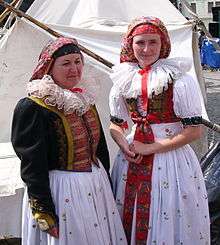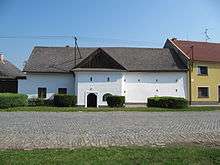Haná



Haná or Hanakia (Czech: Haná or Hanácko, German: Hanna or Hanakei) is an ethnic region in central Moravia in the Czech Republic. Its main parts are located in the lowlands of the rivers of Morava and Haná. It is roughly encircled by the cities of Zábřeh, Holešov, Vyškov and Uničov. Haná is primarily known for its agricultural productivity, costumes, and traditional customs. The Haná dialect (Hanakian dialect or Central Moravian dialect; Czech: hanáčtina) is spoken in the region, and is part of the Central Moravian dialect group. This traditional dialect has been preserved and continues to be used even in printed publications from the region. Folk music from Haná is recognized locally by its lyrics in the Haná dialect.
Name
In the 18th and 19th century, the term "Hanack" (Hanák, French: Hanaque),[1] was used for a Slavic people, peasants, in Moravia.[2] Today, the Czech term Hanáci is used for an ethnographic group inhabiting the Haná region.
Significant cities and places
- Olomouc - the center of Haná and the historical capital of Moravia.
- Přerov - industrial town, well known as archeological significant place where hunters of mammoths settled in Předmostí. Among the town's famous residents was Jan Amos Komenský, known as the "father of modern education". It is common to see hop gardens, fields of poles, and wires around the town.
- Prostějov - nicknamed the "Manchester of Haná" and prior the Holocaust also "Jerusalem of Haná".[3]
- Příkazy - the Haná Open Air Museum
- Svatý Kopeček - a pilgrimage place (Olomouc)
- Hrad Bouzov
- Hostýn - a pilgrimage place (Bystřice pod Hostýnem)
- Kroměříž - nicknamed the "Athens of Haná".[4]
- Litovel - nicknamed the "Venice of Haná".[5]
- Litovelské pomoraví
- Haná River valley - a right tributary of the Morava River
- Kojetín
- Náměšť na Hané
- Javoříčské jeskyně
- Mladečské jeskyně
- Hulín
- Holešov
- Šternberk
- Zámek Chropyně
- Zbrašovské aragonitové jeskyně
- Vyškov - formerly called "Moravian Versailles" or "Versailles of Haná".[6]
See also
| Wikimedia Commons has media related to Haná. |
- Moravia
- Olomouc Region
- South Moravian Region
- Zlín Region
- Hanakian Moravian Slovakia (cs:Hanácké Slovácko)
References
- ↑ Stanislav Brouček; Richard Jeřábek (2007). Lidová kultura: národopisná encyklopedie Čech, Moravy a Slezska. Mladá fronta. ISBN 978-80-204-1711-4.
Hanaque Paisan qui habite les confins de la Moravie - A Hanack. Or a Peasant inhabiting y Con- fines of Moravia
- ↑ Conrad Malte-Brun; Jean-Jacques-Nicolas Huot (1834). A system of universal geography: or A description of all the parts of the world, on a new plan, according to the great natural divisions of the globe. S. Walker. pp. 726–.
the different Slavonic tribes, may still be distinguished, not only in Bohemia, but in Moravia and Silesia, although many German words have been introduced into them. . The Hannack is harsh in its pronunciation ; the Slowack is divided into two sub-dialects, the Moravian Slowack, which is spoken by the Slowacks and the ...
- ↑ "Holocaust v Prostějově". Retrieved 1 November 2012.
- ↑ "Welcoming Kromeriz boasts a UNESCO sight". Retrieved 1 November 2012.
- ↑ "Hanácké Benátky 2012". Retrieved 1 November 2012.
- ↑ "Vyškov". Retrieved 1 November 2012.
External links
- (English) Central Moravia
- (Czech) Folklore from Haná
- (English) Folklore group Hanačka
- (Czech) about the Haná dialect